Ghana
An African Portrait Revisited
by Skye Wentworth
This week President Obama will visit Ghana on his first official trip to sub-Saharan Africa. For those who wish they could tag along on the President’s historic visit, award-winning photographer and editor Peter E. Randall’s lush book, Ghana: An African Portrait Revisited offers a vivid virtual tour of the West African nation.

Peter E. Randall
In the spring of 2006, inspired by the work of master American photographer/film maker Paul Strand, Randall invited five fellow photographers to journey with him to Ghana — to document the country on the eve of its fiftieth anniversary of independence. The result is a stunning portrait that documents that nation Obama’s administration refers to as “one of our most trusted partners in sub-Saharan Africa.”
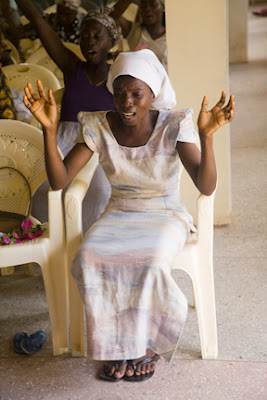
Revival meeting, West Legon, Ghana. Photograph by Peter Randall, from Ghana, An African Portrait Revisited.
Ghana: An African Portrait Revisited has been recognized by “Shutterbug Magazine” as one of the top photography books of 2008. Ghana: An African Portrait Revisited was also one of three finalists in the coffee table/large format category for a 2008 Benjamin Franklin Award given by the Publisher’s Marketing Association, now the Independent Book Publishers of America.
More than 150 full-color photographs juxtapose Ghana’s traditional character with its entry into the competitive global marketplace, with images ranging from bead makers and wood carvers, to Accra’s urban skyline and Tema’s modern port facilities. Ghanian poetry and commentary gives depth and perspective to this beautiful and timely book, with a featured essay by poet and scholar Abena P.A. Busia, daughter of a former Ghanian prime minister and faculty member of Rutgers University.
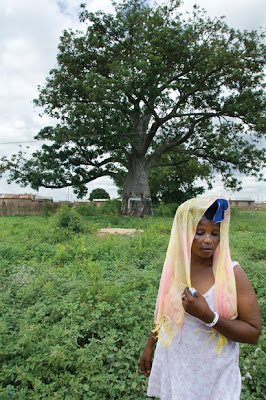
Caretaker of the ancient baobab tree where slaves were tied in the sun as punishment at the slave market, Salaga, Ghana. Photograph by Tim Gaudreau, from Ghana, An African Portrait Revisited.
Ghana: An African Portrait Revisited captures the color, warmth, and vitality of contemporary Ghana. In the words of Minister of Tourism J.O. Obetsebi-Lamptey, Randall’s book “gently exposes Africa's best-kept tourism secret with such art that you will be tempted to visit and see for yourself."
Peter E. Randall, editor and photographer of Ghana: An African Portrait Revisited has been photographing New England since the 1960s, and has published fourteen books. His travels include Japan, Guatemala, and Ghana, and other African countries.
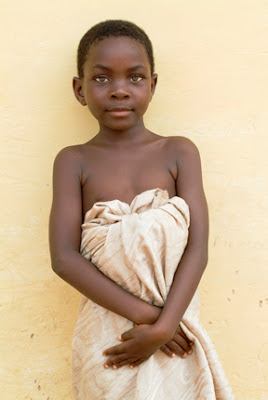
Sara Kumi, Aburi, Ghana. Photograph by Gary Samson, from Ghana, An African Portrait Revisited.
Peter has a Photography Web site at: petererandall.com, where you can see images from New Hampshire as well as galleries of Peter's other photographic works. He lives in Portsmouth, New Hampshire.
On Monday I was fortunate to catch up with Peter, just back from a workshop in Owls Head, Maine, and talk to him about his book, his experience in Ghana and what he expects President Barrack Obama plans to discuss with Ghanaian President John Atta-Mills.
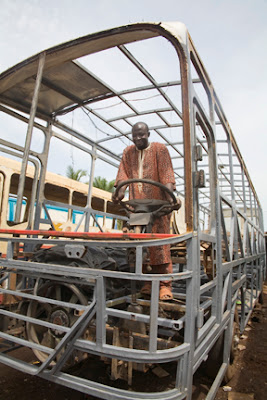
Bus awaiting reconstruction. Kumasi, Ghana. Photograph by Barbara Bickford, from Ghana, An African Portrait Revisited.
SW (Skye Wentworth): What was the main attraction that brought you to Ghana and how did the idea of the book come about?
PER (Peter E. Randall): As mentioned in the preface of Ghana: An African Portrait Revisited, the idea for the book began in 1984 when I was hired as a consultant for the Food and Agriculture Organization of the United Nations to go to Ghana. My assignment was to document an improved method of smoking fish.
With little access to refrigeration, many Third World People resort to smoking as the only viable alternative to preserve their catch. My friends Bill Brownell and Jocelyn Lopez expanded a project to smoke fish using a mud-brick oven for the fire and wooden trays lined with chicken wire to hold the fish. Called Chokkor after the village where the technique was first used, this method allowed fifteen times the amount of fish to be smoked at once using the same amount of wood as the usual method, which used a fifty-five gallon oil drum.
Traveling around the country in 1984, I met many friendly Ghanaians and resolved to return to this West African Country. As part of my research before visiting Ghana in 1984, I discovered that one of the great photographers of the twentieth century, Paul Strand, had been invited to document the country by Kwame Nkrumah, the nation’s first president. Long a British colony, Ghana in 1957 was the first sub-Saharan country to become an independent nation.
Strand, then seventy-three, and his wife spent six months during 1963-64 traveling throughout Ghana with a car and driver supplied by Nkrumah. Working with a large format camera, Strand made some 500 images. In February 1966 while Nkrumah was away on a state visit to Beijing, China, his government was overthrown in a military coup. Nkrumah never returned to Ghana and died in 1972 in Romania where he was being treated for cancer.
Strand’s photographs were eventually used in a book, Ghana, An African Portrait, published by Aperture in 1976, the year Strand died.

Family, Jordan Nu, Ghana. Photograph by Charter Weeks, from Ghana, An African Portrait Revisited.
SW: Is this what triggered your idea to revisit Ghana and do your own photo documentary, 40 years after Strand’s landmark work? What was the vision you had in mind for this project?
PER: As I looked at, and contemplated, Strand’s work, I thought someone should go to Ghana and document the country 40 years after Strand – on the eve of its fiftieth anniversary of independence. Why not I?
I considered various approaches to the project and, after concluding that I had neither the resources not the time to spend six months in Ghana, decided to make the book a collaboration. I invited several New Hampshire friends to join me on a three-week photography excursion to Ghana in May 2006. Much to my joy, five of whom enthusiastically agreed to accompany me.
Clearly, photographing after Strand was to be a challenge. While we had as a goal “photographing in the manner of Strand, “ we brought our own vision to the project. We were six photographers with six points of view and six ways of working to present a unique portrait of the country. Strand photographed slowly over half a year with a large-format camera in black and white. Most of us used digital cameras and we decided to work in color during our three-week trip.
Strand was and remains our inspiration. He showed the world Africa’s first sub-Saharan independent country. His book is filled with portraits of proud Ghanaians, people who looked to the future with hope and dignity.
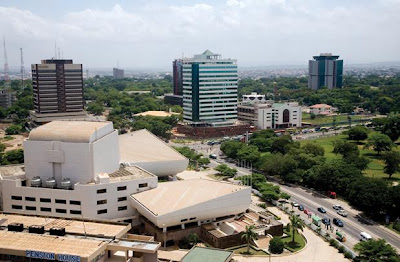
National Theater and modern office buildings, Accra, Ghana. Photograph by Peter Randall, from Ghana, An African Portrait Revisited.
SW: Tell us about the five chosen photographers who agreed to accompany you to Ghana and partner with you on the book, Ghana, An African Portrait Revisited.
PER: Charter Weeks and I were students at the University of New Hampshire and during a long career his work has included travels to Japan and in Niger and filmmaking in London and the United States.
Gary Samson and I have been friends since 1978, when we met at a UNH (University of New Hampshire) Isles of Shoals exhibit at which some of my images were on display. Gary worked for 29 years at UNH making documentary movies and managing the university’s photographic services department. He now chairs the photography department at the New Hampshire Institute of Art. Gary worked with me to found the New Hampshire Society of Photographic Artists (NHSPA).
Nancy Grace Horton, a full-time Portsmouth photographer, does commercial and editorial assignments throughout New England and the East Coast and has traveled extensively.
Tim Gaudreau combines his photography with video, new media, graphics and sculpture to create public art. He does commercial and editorial photography from his Portsmouth studio and has traveled to India and Brazil.
Barbara Bickford’s work extends to many Southeast Asian countries including Vietnam and Cambodia. She, along with Nancy and Tim, is a member of NHSPA.
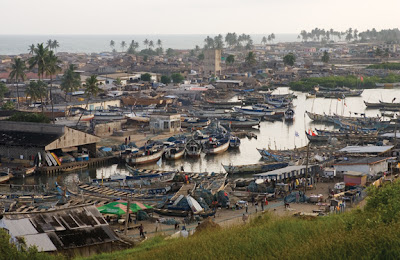
Fishing boats, Elmina, Ghana. Photograph by Peter Randall, from Ghana, An African Portrait Revisited.
SW: President Obama will make his first official trip to sub-Saharan Africa this coming week, July 10-11, spending two days in Ghana with his wife, Michelle. The visit of the first African American U.S. president will likely draw a huge crowd across the continent. What is the reason for Obama’s visit? What do you foresee this historic event will bring to both countries?
PER: I think President Obama’s visit to Ghana is a statement of respect for the tremendous effort Ghanaians have made in recent years to change peacefully from a dictatorship to a stable democracy, with an improving economy. Ghanaians are a friendly, outgoing people, fond of music and skilled at crafts. Travel to Ghana can only benefit the people, while Ghanaians can bring to America their culture and work ethic. Barely 200 years ago, Ghanaians came to America as slaves; now they can come on their own, examples of how, over time, the world does change for the better. For Africans, Ghana’s transition to democracy is certainly a strong statement to its neighbors that life can improve and peace is not just a dream. President Obama’s journey reinforces America’s commitment to Africa and its people.
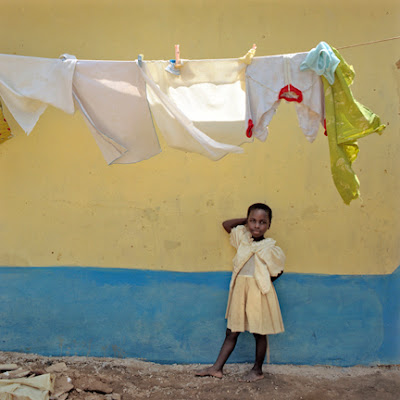
Village scene, Esssueshyai, Ghana. Photograph by Nancy Grace Horton, from Ghana, An African Portrait Revisited.

Ghana: An African Portrait Revisited (Peter E. Randall Publisher LLC, ISBN 978-1931807579, Documentary Photography, full color, cloth with jacket, 10.25” x 10.25”, 168 pages, 2007, $40.) can be purchased directly from the publisher, at http://www.perpublisher.com, or from your favorite online bookstore. Visit http://www.ghanavisit.org to learn more about the book.
Skye Wentworth, http://www.skyewentworth.org, is a book publicist who specializes in creating award-winning publicity campaigns for authors and publishers.
Feature photo: St. Georges Fort, where slaves were kept prior to shipment, Elmina, Ghana. Photograph by Peter Randall, from Ghana, An African Portrait Revisited
All photos courtesy and copyright of Peter E. Randall, Ghana, An African Portrait Revisited
